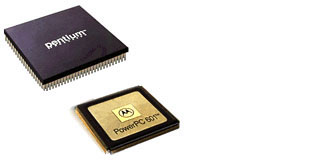
RISC versus CISCWhile I still believe that the RISC architecture is superior to CISC there is currently little practical difference between them. Apple have switched to the Intel architecture which is based on a CISC architecture but now incorporates some RISC elements as well. They abandoned the purer RISC PowerPC platform not because it was technologically inferior but because the market forces allowed Intel to do a better job at producing processors at a better price than IBM and Motorola. About RISCRISC stands for Reduced Instruction Set Computer. It is a technique for making faster computers that has been around for a while now but hasn't been widely used in desktop machines. The major philosophical difference between conventional or CISC (Complex Instruction Set Computer) computers and RISC is that instead of having a large set of slow, complicated instructions the computer can perform, RISC has a small set of fast instructions. The program used to write programs, the compiler, is responsible for assembling these small instructions into efficient units to perform the required task. Computers have a basic speed of operation measured in millions of cycles per second or megahertz (MHz). The problem is conventional computers take several cycles to perform one instruction. For example a Mac Plus takes about 8 to perform one, so an 8MHz Mac really only does 1 million instructions each second. RISC technology allows the computer to do one instruction every cycle (sometimes more) so a 110 MHz PowerMac can do about 100 million instructions each second. This is usually achieved by using several advanced techniques such as caching, pipelining and superscalar architectures. About PipeliningPipelining is a technique used to increase the performance of computers. Basically, it involves breaking instructions into small parts and processing different parts of a sequence of instructions at the same time. For example when one instruction is being executed the next one could be having a required address calculated and the one after that could be being interpreted. See the entry for RISC and Superscalar for more information about high performance CPUs. About Superscalar ArchitectureSuperscalar architectures increase the speed of computers by executing several instructions at the same time. For example the PowerPC 601 processor has 5 pipelines so it can theoretically execute 5 instructions simultaneously. The pipelines are specialised: there are two integer, two floating point and one branch prediction, so the real speed gain depends on the program. That is one reason why programs need to be re-written to take full advantage of the PowerPC. See the entry for RISC for more information about high performance CPUs. ![[Back]](../XuShared/Back2B.jpeg)
Insert query failed: INSERT INTO log VALUES (NULL,1,'2025-12-21','162642','RISC.html','XuMacInfo','216.73.216.208','Mozilla/5.0 AppleWebKit/537.36 (KHTML, like Gecko; compatible; ClaudeBot/1.0; +claudebot@a','');. |